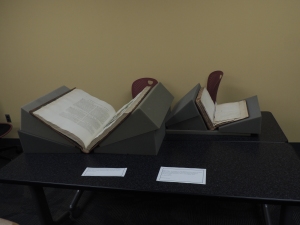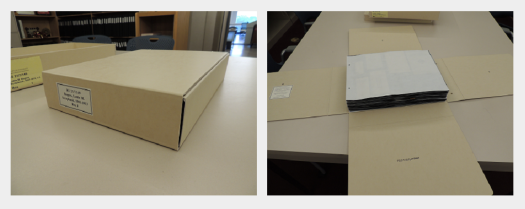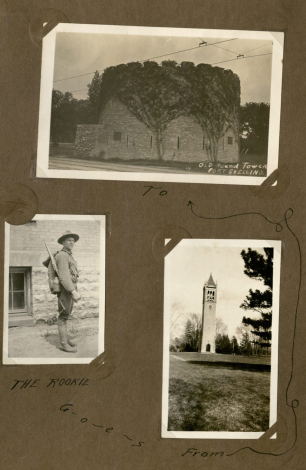Have you ever wondered what it takes to put together a pop-up exhibit? Last Friday, Special Collections & University Archives (SCUA) exhibited about two dozen items for three hours for Iowa State’s Homecoming. The temporary exhibit was open to the public, but our focus was alumni visiting for Homecoming. Today’s post is about our process.
Dry Run
Back in mid-August, we invited the Alumni Center to drop by and see what items we thought we’d include in the October Homecoming exhibit. This dry run entailed staff from the department brainstorming on what items would be best to put on exhibit and what order they should be displayed. Labels were made and the classroom was rearranged into an exhibit space. Heather Botine, Associate Director for Constituent Engagement, dropped by and gave us feedback on how we set the room up and what kinds of materials may engage alumni more. We also discussed what reproductions SCUA could provide for digital display over at the Alumni Center.

Two weeks out
We made sure to promote our Homecoming event in the library and in our social media. We enlisted the help of Monica Gillen, the Communication Specialist for the library, and Jody Kalvik, Instruction, Program Coordinator. Monica helped get the word out and Jody designed flyers, posters, a banner, and our signage.
The week before before Homecoming
We did one last practice run. We tweaked our list of items on display and took into account Heather’s set-up advice. We also invited Sonya Barron, Conservator, to drop by. Sonya ensured our items were sturdy enough to display, offered to provide mounts, and advised us how to safely display materials. We also made final decisions on what would be in the temporary exhibit and what order we wanted to display items, there was some rearrangement. Pictures were taken of materials so we’d know how to set up the following week.

The week of Homecoming
Now that we had our exhibit finalists, we had to finish drafting and mounting the labels.
Friday of Homecoming!
We spent the morning setting up and our doors opened at 1 pm. We were so pleased at the opportunity to show off our treasures.

Thank you to everyone who visited us last Friday at 405 Parks Library. To those that missed seeing our treasures on display, drop by and see us sometime. We’re open from 9-5, Monday-Friday.
























 The above image comes from one of the scrapbooks in the collection, and shows the cast for a Cosmopolitan Night Play from November 28, 1928.
The above image comes from one of the scrapbooks in the collection, and shows the cast for a Cosmopolitan Night Play from November 28, 1928.



